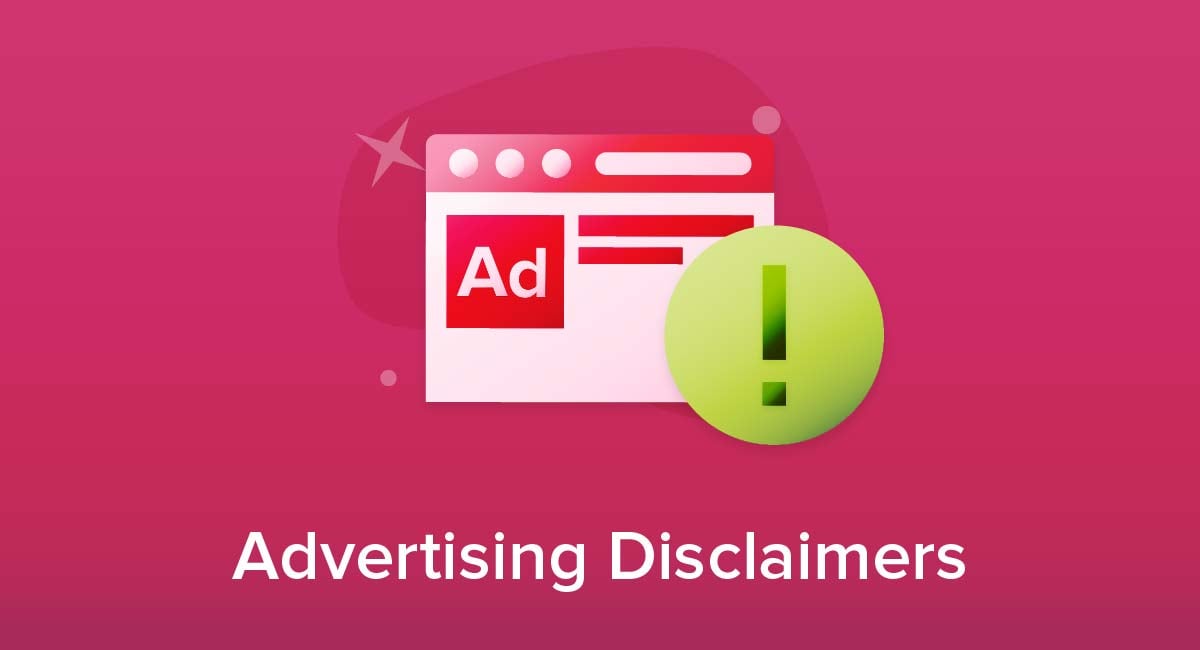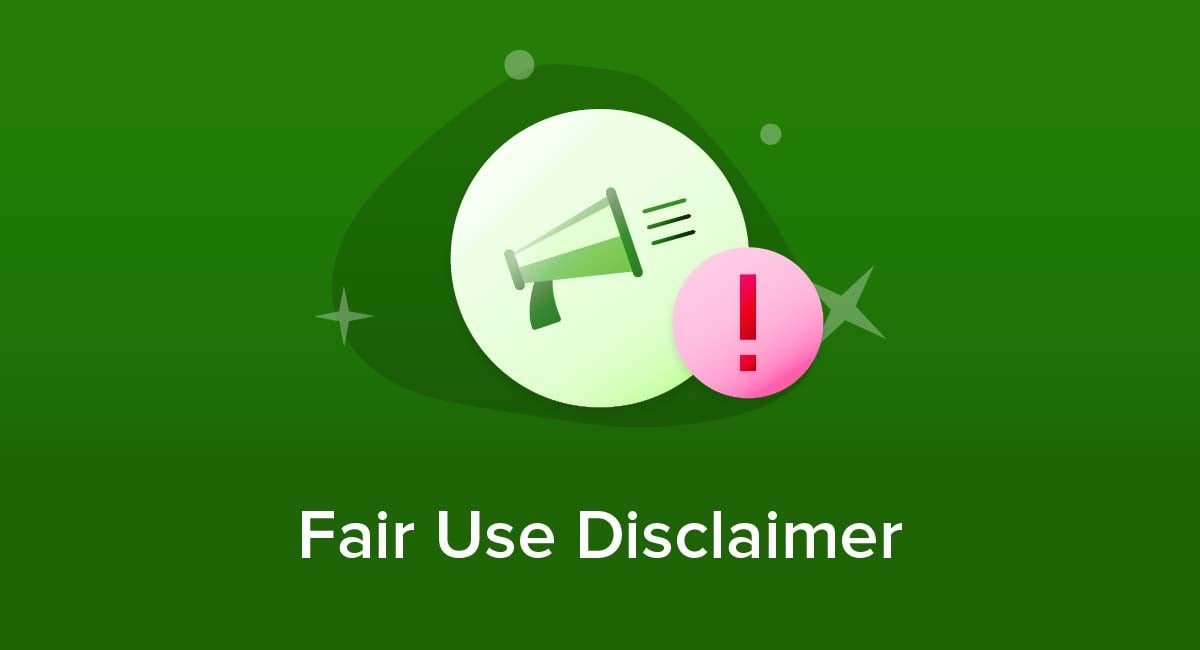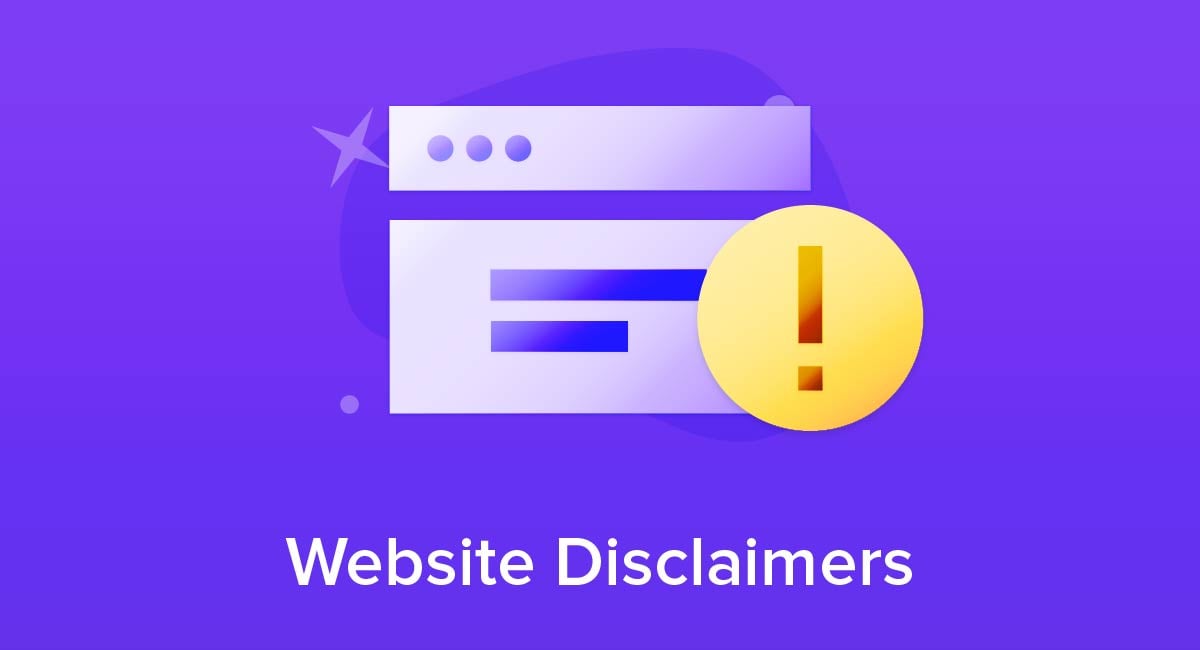
If you're getting ready to draft disclaimers for a website or blog, picking which ones you need can seem daunting. With so many different types of disclaimers available, you want to make sure you pick the right ones for your purposes.
This article will help you learn what disclaimers are, the most common ones, who needs which disclaimer, and where to include them.
Let's get started.
Our Free Disclaimer Generator is designed to help you comply with the requirements of various affiliate programs, such as Amazon Associates. It also includes various disclaimers like medical disclaimer, fitness disclaimer, website disclaimer and so on.
Just follow these few simple steps and generate a Free Disclaimer for your site or your app:
- Start by choosing the "Free Disclaimer Generator" on our site.
-
Then select where your Disclaimer will be used on:
-
Follow with adding your website/app information:
-
Enter the country and click on the "Next Step" button:
-
Continue with building your Disclaimer and answer on questions about your business from our wizard:
-
Now just enter your email address where you'd like your Disclaimer sent and click on the "Generate" button.
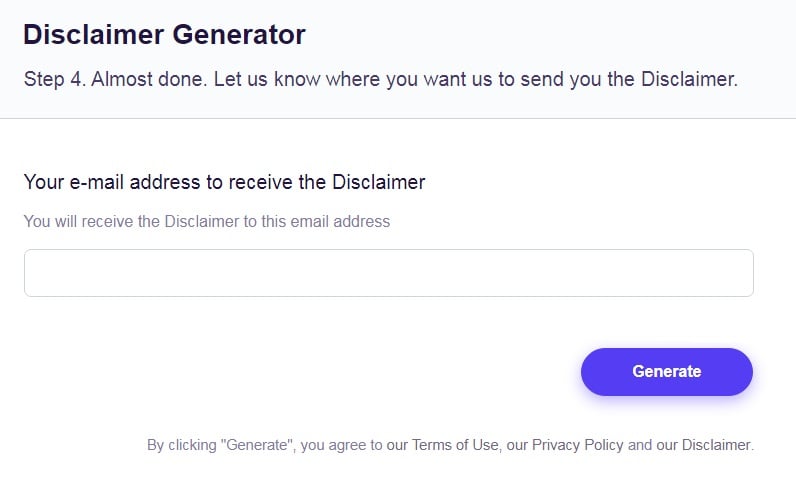
You're done! You can copy and paste your Disclaimer code into your website/app, or link to your hosted Disclaimer page.
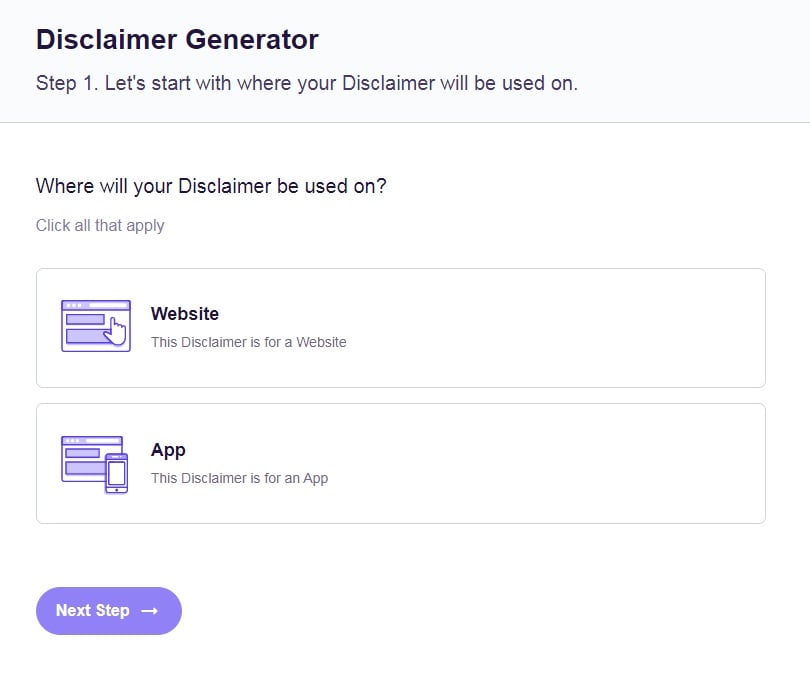
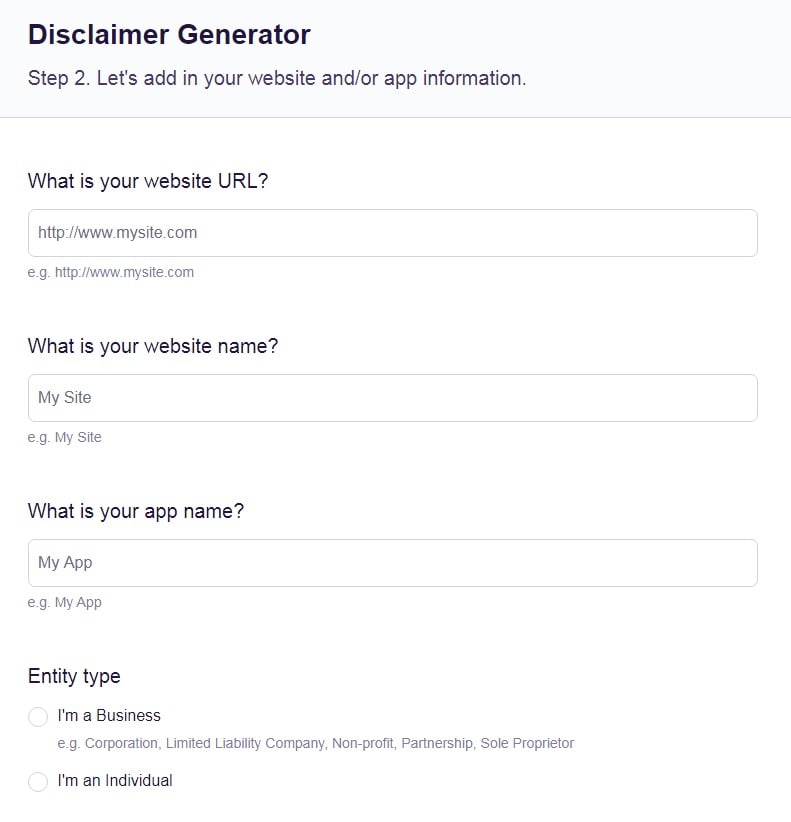
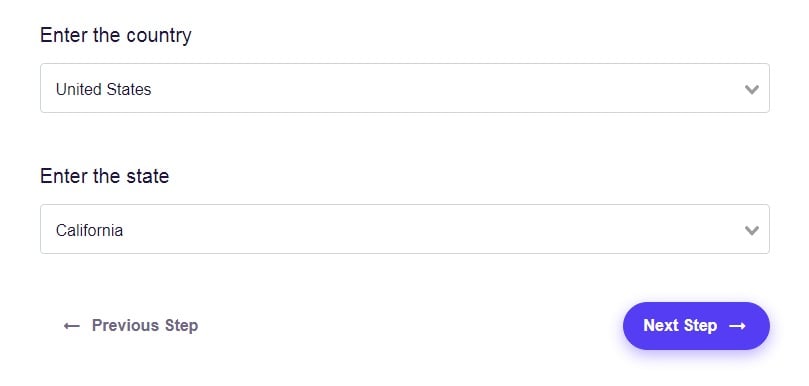
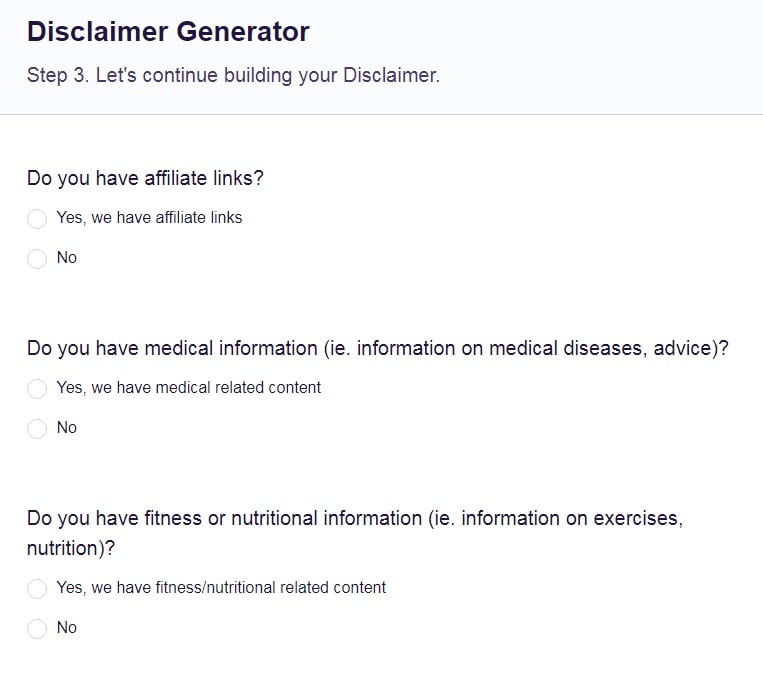
- 1. What are Disclaimers?
- 2. Types of Disclaimers
- 2.1. Ad Affiliation Disclaimers
- 2.2. Third-Party Services Disclaimers
- 2.3. Disclaimer of Warranty
- 2.4. Limitation of Liability
- 2.5. Medical/Legal/Financial Disclaimer
- 2.6. Shipping Disclaimer
- 2.7. Return Policy Disclaimer
- 2.8. Affiliate Disclaimer
- 3. Where to Display Your Website Disclaimers
- 3.1. In a Terms and Conditions Agreement
- 3.2. In a Website Footer
- 3.3. On Pages with Relevant Content
- 3.4. On a Separate Webpage
- 4. Summary
What are Disclaimers?
Disclaimers are statements that notify users of what your website disclaims, or does not promise. They can also be a way of putting your users on notice of specific relationships, partnerships, or affiliates users may find when using your site. They help create transparency between the visitor and the website so users are not caught off-guard when interacting with the site.
However, the main function of a disclaimer is to limit your liability if a user pursues legal action based upon the use of your site.
Most disclaimers are not legally required and some courts haven't upheld them as they are not a legally binding agreement. However, not having any disclaimers can leave you open to potential liability.
Disclaimers are different from a Privacy Policy or Terms and Conditions agreement as they are not legal agreements, but are statements made by your website about the limitation of your site's liability or what your site does not promise in regard to your content.
Types of Disclaimers

There are a multitude of disclaimers you can include on your website. Which ones you include depends on your website, service, and what types of content you provide.
While there are many disclaimers to be aware of, here are a few key ones to pay attention to:
- Ad affiliation
- Third-party services
- Disclaimer of Warranty
- Limitation of Liability
- Medical/Legal/Financial
- Shipping
- Return/Exchange
- Affiliate
Not every website will have all of these disclaimers or your website may even have more than these. Make sure to tailor which disclaimers you include to fit your website and your content.
Ad Affiliation Disclaimers
Ad affiliation disclaimers are statements notifying visitors that the website partners or is affiliated with a particular ad creation service. What this means is that a website will sign up to join one of these services and it will use tools (i.e. cookies) to look at what a user's interest is and populate ads that fit those interests onto a website.
This doesn't mean a website or blog owner specifically chooses an ad for its sidebar, but places a link and the service puts the ad in based on the search history of the visitor.
Websites include these ads as a way to make passive, small income off of clicks on the ads. Websites, blogs, or apps that partner with an ad affiliate should have this disclaimer on their website so users are aware of the relationship between the website and the ad service.
As we mentioned above, transparency between websites and users is paramount for privacy laws. Making sure a visitor is aware of what the ads mean plays into that.
For an example of how to do this, take a look at Love and Lemons Advertising Privacy Statement:

Love and Lemons makes sure visitors are aware that the business has partnered with CMI Marketing/CafeMedia to put ads on the website. If you include this disclaimer, you should include what service you are affiliated with, explain how the advertising works, and how it affects the visitor.
Third-Party Services Disclaimers
Most websites include links to other websites or services on their own site. This is a way for the website to make money, feature other links, bring in traffic to the site, or help build a brand.
These "third-party services" are typically links strategically placed for users to click on or are a sponsored or affiliate link. Like an ad affiliation disclaimer, this disclaimer makes users aware that there are third-party links on your site.
Where this disclaimer is different is it states visitors click on the third-party links at their own risk. This disclaimer limits the liability of the website if there is an issue when clicking on the third-party link. If you have these types of links, it's highly recommended that you include this disclaimer.
BuzzFeed's Third Party Services disclaimer does a good job of clearly explaining that it does feature links for sponsorships and other websites:
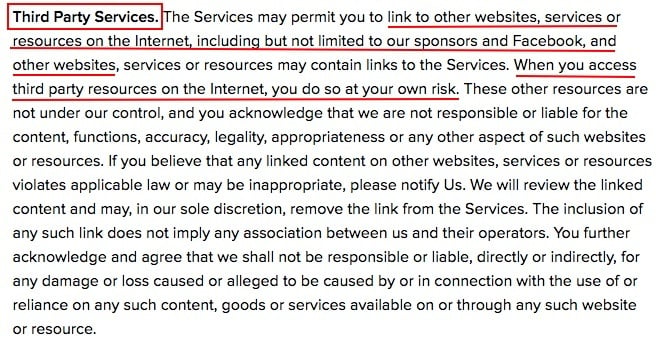
What's especially important about this disclaimer that you should note is how BuzzFeed states that when clicking on these links users do it at "your own risk." Having this phrase in your disclaimer helps to limit any potential liability that may arise.
Disclaimer of Warranty

One of the most common disclaimers for any website is a Disclaimer of Warranty. We stated earlier that disclaimers can state what the website disclaims or does not promise to users. A Disclaimer of Warranty is specifically designed for this.
It's your website's statement that your site doesn't promise visitors won't have issues when visiting the site. This can include that the site won't necessarily always be error-free or uninterrupted.
Amazon's Disclaimer of Warranty is a good example of how you can relay this to users:
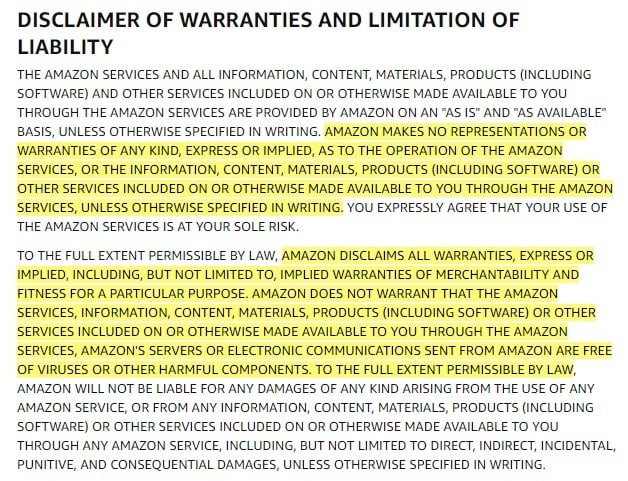
This disclaimer is highly recommended for any website or blog. Since it covers your entire website, it's a good idea to have one in case someone's use of the site is interrupted.
In addition to listing off what you disclaim, a key phrase you may want to include is that users take the site "AS IS" or "AS-AVAILABLE." This statement notifies users that they are taking the site as is, with any bugs, inaccuracies, or issues that may come with it. It's another way to safeguard your site against liability.
Here's how Apple does it:
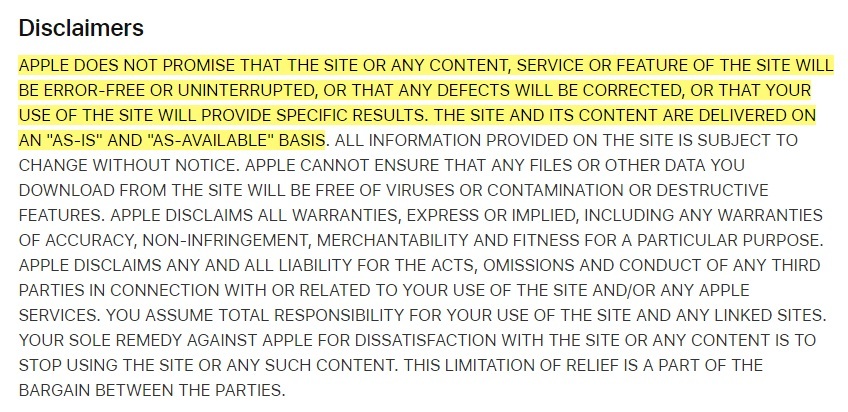
Limitation of Liability
One of the most common disclaimers you'll find on any website or blog is a limitation of liability. While a disclaimer of warranty states what your website does not promise, a limitation of liability states the limitations of your site's liability to users. This disclaimer is a key piece to protecting your site from any issues down the road.
A limitation of liability disclaimer makes clear there is a limit to your site's liability if a user encounters issues while using the site.
When drafting your disclaimer, a key statement you may want to include is that your website "shall" not be liable. This expressly limits your liability. Along with this you can also include what types of damages you won't be liable for, such as:
- Direct
- Indirect
- Punitive
- Consequential
Here's how Twitter clearly states what types of damages it is not liable for in a clear and understandable manner:
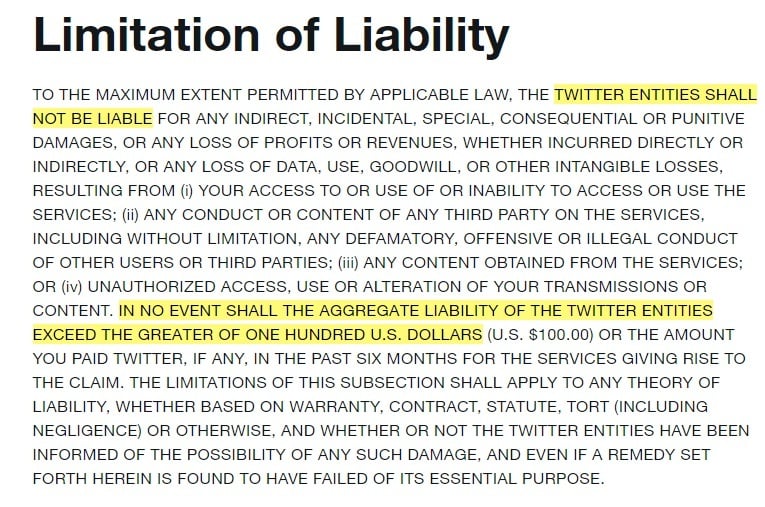
For another way to do this, check out Hulu's limitation of liability disclaimer:
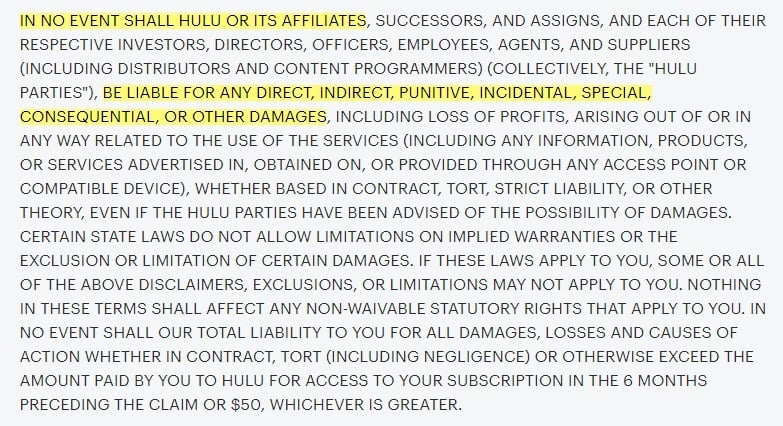
It also reminds users that this disclaimer may not apply to every user depending on where they live. It's important to remember that disclaimers don't apply to everyone and you should make sure to inform users of this.
Medical/Legal/Financial Disclaimer
These disclaimers are not for every website. If you have a website or blog that features tips, advice, stories, or sells products related to one of these fields, you should consider putting a disclaimer on your website.
These particular disclaimers notify users of how they should interact with your site and how they should consider your informational content. It can also limit the misunderstandings a user may have about your site.
For example, if you are a health blog talking about a diet that worked for you, a user may believe you are a dietician and take your word without seeing a doctor. If they end up suffering damages because of this and you don't have a disclaimer, you could be potentially liable.
When drafting these disclaimers you need to make it clear that your website is not professional advice and should not be construed that way. Oftentimes this means stating the site is for "educational, informational, or entertainment purposes" as Peloton does on its site:
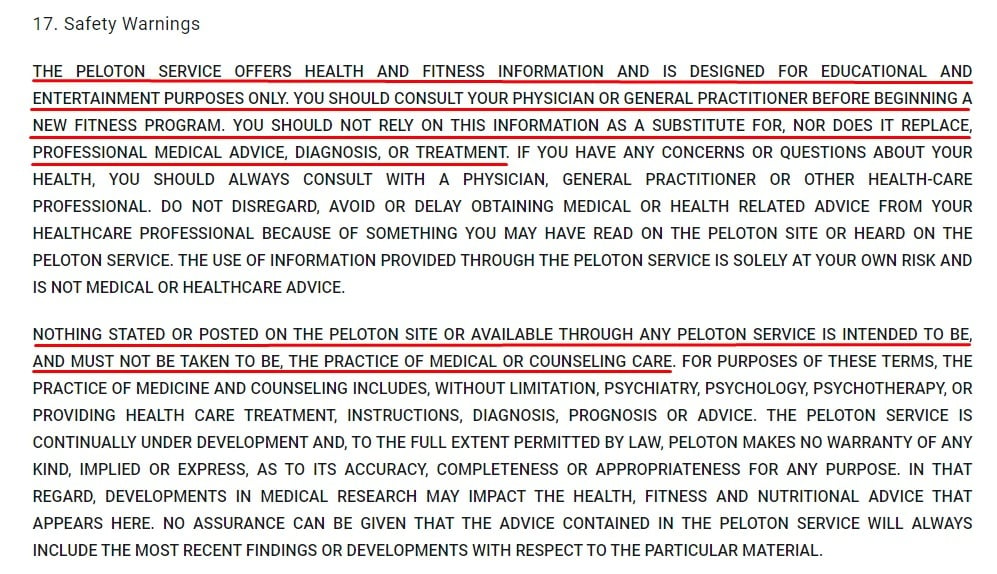
You don't want the user to be confused that your website or blog is advice from a professional lawyer, doctor, or accountant. Including how your site should be perceived and what its purpose is, can go a long way in safeguarding your site.
Medical and legal websites or blogs are two of the most common sites that include these disclaimers, but financial websites also should have a disclaimer as well, just like NerdWallet does:

If you offer any sort of advice, information or content that users may follow with expectations of results, you should include some type of disclaimer that makes it clear that you are not giving professional advice.
Shipping Disclaimer

Not every website will need to include a shipping disclaimer. These disclaimers are meant for ecommerce websites that ship their goods to users whether the website is solely on the internet or if it has a brick-and-mortar store.
A shipping disclaimer allows your website to remind users of what your site disclaims when it comes to shipping goods. It also can be a way of limiting your liability if there is an issue during shipping, such as the package is damaged or it may take longer than normal.
H&M's Shipping Limitation disclaimer informs users that when they accept the terms of the website they are accepting the shipment conditions of H&M and that the shipments will be sent out only if they comply with those conditions.

You generally will find these disclaimers in a Shipping Policy, but you can also find them in the site's Terms and Conditions.
Return Policy Disclaimer
Similar to a shipping disclaimer, a return policy disclaimer dictates what the limitations are for when a customer wants to return or exchange an item they have purchased. This is an important disclaimer for ecommerce stores.
A return policy disclaimer is typically found in the site's Return Policy and can be as detailed or basic as you want. Some stores have many restrictions when it comes to returning an item, and others have few. While others allow some items to be returned and some can never be returned, such as final sale items.
Whatever restrictions you put in your return policy disclaimer, you need to be clear and it needs to be understandable so users won't be confused. You can do this by including a few paragraphs or laying out the restrictions in bullet points, like Anthropologie does:
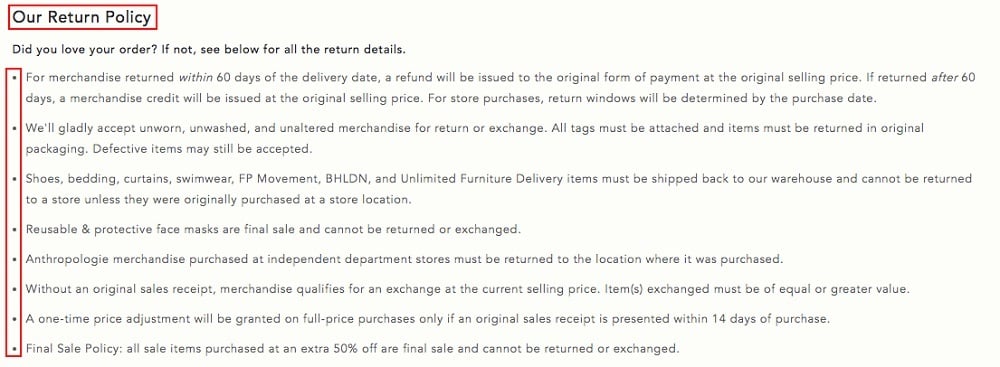
Affiliate Disclaimer
Quite common for blogs, and websites, is an affiliate disclaimer. An affiliate disclaimer notifies users of whether the site has partnered with an affiliate advertising program, such as Amazon.
When a blog or website signs up with an affiliate program, they can receive a small commission off of the reviews, affiliated links, or affiliated sites that it features on its page when a user purchases the item. However, this affiliation needs to be disclosed and is required by some programs.
For example, if your site is affiliated with the Amazon Associates Program, Amazon requires you to disclose this affiliation. You need to state that there are affiliated links on your website and that you receive a small commission from them.
Hello Glow is a good example of how you can do this:

In addition to Amazon, the Federal Trade Commission (FTC) also requires that endorsements or affiliations be disclosed. This goes back to keeping transparency between the user and the website.
The FTC requires that your disclaimer be clear, conspicuous, and understandable. Not everyone knows what an affiliate link is. It can be helpful to state in your disclaimer how you receive a commission and for what.
The Points Guy does this in its disclaimer by stating it's compensated when there is a "user action" (or a link click):

While your website may need all or just a few of these disclaimers, now you have a good base for understanding some of the most common, important disclaimers and what purposes they serve.
Having appropriate disclaimers will benefit both you and your users. You'll get the benefits of limited liability and appearing more trustworthy and transparent while your users will get important information disclosed to them.
Where to Display Your Website Disclaimers

You can display your disclaimers almost anywhere on your website. Where you have your disclaimer will depend on what type of disclaimer it is. Some you can solely include in your Terms and Conditions agreement, while others you should have in multiple locations.
Since most disclaimers are not legally required, there is no requirement for where you must include them. However, there are some laws that require your disclaimer to be accessible. For example, under the FTC your affiliate disclaimer must be "clear and conspicuous." This means this type of disclaimer shouldn't be hidden in another agreement, but should be in a footer or its own separate page.
Let's take a look at a few other places you can put your disclaimers.
In a Terms and Conditions Agreement
One of the most common places to include most disclaimers is in the Terms and Conditions Agreement. Since this agreement deals with how users can interact and use the site, it makes sense to include disclaimers.
The three most common disclaimers you'll find in a T&C are Disclaimer of Warranties, Limitation of Liabilities, and Third-Party Disclaimers. But you can also find others as well.
Nationwide's Terms and Conditions table of contents is an example of this:
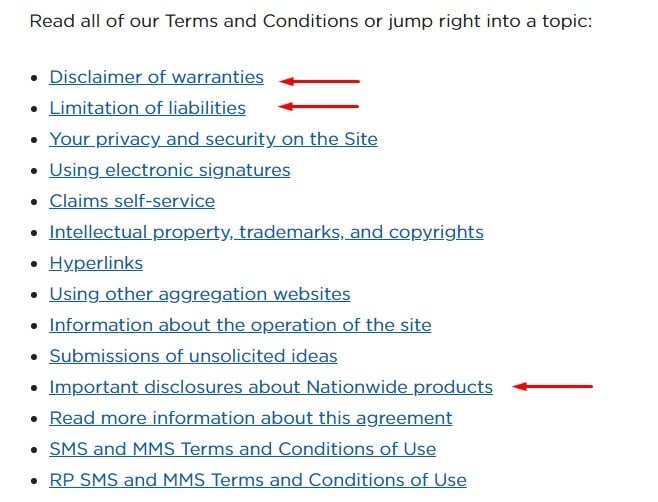
In a Website Footer
Another popular place to include a disclaimer is in the footer of your page. Most people typically look for legal documents or links in the footer of a webpage, so it's a good idea to include your disclaimer there.
NerdWallet includes its financial disclaimer in its footer so users can easily understand that the website is not professional advice:
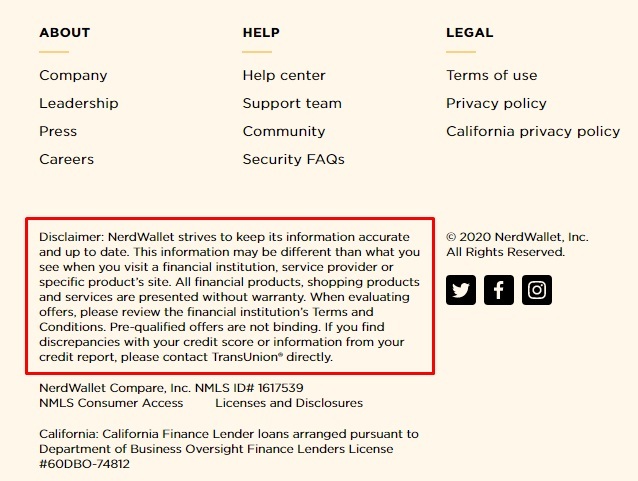
Not every disclaimer will fit in the footer. Most disclaimers you'll find in footers are affiliate disclaimers, professional disclaimers, or ad disclaimers since these tend to be shorter.
On Pages with Relevant Content
Typical for blogs, another option is including a disclaimer on every page that has specific, relevant content. The most common example here would be the affiliate disclaimer. Under the FTC and Amazon, it's recommended that disclaimers be included "as close to" the content as possible to limit confusion.
This is why on many blogs you'll find a disclaimer on each page that has affiliate links so users aren't misled or confused about which products or links are an affiliate.
Nomadic Matt includes this disclaimer on every page that has an affiliate link:

On a Separate Webpage
You can also have a completely separate page for your disclaimers. This page can include all of your disclaimers from a Limitation of Liability to a medical disclaimer to an ad affiliate disclaimer. This option can allow your users to easily access every disclaimer for your website in one place.
Fit Bottomed Girls is an example of this. It has a link in its footer to a separate "Disclaimer, Privacy Policy, & Terms of Use" page where a user can find out everything they need to know in one spot:

The full disclaimer page has each disclaimer one after another in one easy to navigate location:
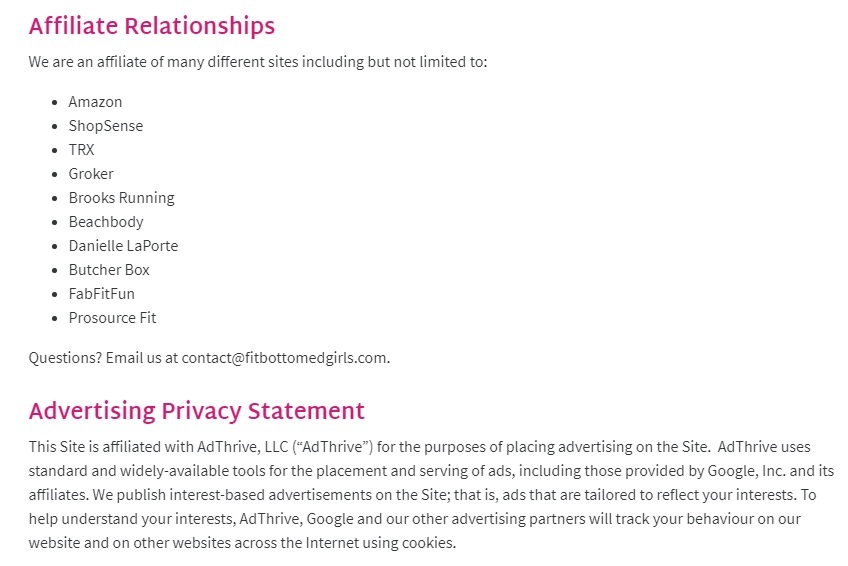
Summary
If you're thinking you may need a disclaimer for your website, first determine what type of website or service you have. What disclaimers you include on your site will entirely depend on your type of website.
Also, make sure that your disclaimers are clear and easy to understand. Privacy laws don't like it when websites or blogs aren't transparent with their legal agreements and statements.
Keep in mind that your disclaimers will need to be accessible and conspicuous, so it's recommended to be mindful of where you put your disclaimer, too.

